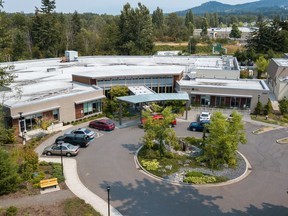It’s estimated 4,800 B.C. patients will be treated at the PeaceHealth St. Joseph Cancer Center and the North Cascade Cancer Center in Bellingham in the next two years
Sending people with prostate and breast cancer across the border for radiation treatment is a short-term solution that doesn’t address the long waiting times for diagnostic imaging and the initial oncology appointment, say two Metro Vancouver doctors who work with cancer patients.
Dr. Chris Hoag, a urologist and past president of the Consultant Specialists of B.C., said this week’s announcement that eligible breast and prostate cancer patients will be sent to one of two clinics in Bellingham for radiation is great news for patients, but “it’s a sad state of affairs that our system has declined to the point where we’re now asking to send patients to another country to get treated.”
It’s estimated 4,800 people will be treated at the PeaceHealth St. Joseph Cancer Center and the North Cascade Cancer Center over the next two years, representing about 20 per cent of the 14,000 B.C. cancer patients who receive radiation therapy each year.
It’s an unprecedented move to address the backlog for cancer treatment in B.C. which has one of the longest waits for radiation therapy in Canada.
Leaked B.C. Cancer data released by B.C. United late Wednesday afternoon shows the percentage of cancer patients who start radiation treatment within the Canadian benchmark of 28 days is currently just 77 per cent, much lower than the 82.9 per cent quoted by Health Minister Adrian Dix on Monday. It’s also well below the national average of 97 per cent and one of the worst rates in the country.
No one from B.C. Cancer or the Health Ministry responded to questions about the leaked wait time figures before deadline.
Dix told Postmedia News on Tuesday he’d like 95 to 100 per cent of cancer patients to start radiation within 28 days, which is why the province looked to the Bellingham clinics to ease the pressure on B.C.’s overstretched system.
However, Hoag said the “temporary stop gap” measure won’t address the “upstream waits” for diagnostic imaging before a diagnosis or the often months-long wait to even see an oncologist.
He said he’s often stunned when he follows up with his patients two months later and they still haven’t had their first oncology appointment.
Hoag was one of 26 medical specialists who signed a letter sent to Dix in September raising the alarm about dangerously long waiting times that leave patients to suffer and die as they wait for care.
According to the letter, it’s typical for patients in Metro Vancouver and Vancouver Island to wait two to three months to first see an oncologist after a cancer diagnosis.
“Ninety-seven per cent of referrals to B.C. Cancer come from specialists, so if we don’t address the waits to see those specialists, we’re not really addressing the major issues with cancer care,” he said.
Dr. Alison Harris, vice-president of the Canadian Association of Radiologists and a radiologist at Vancouver General Hospital, said the association is pushing the federal and provincial governments for more medical imaging equipment, which is crucial in diagnosing cancer and determining if cancer treatments have been effective.
Patients are experiencing delays in their care due to a lack of adequate medical equipment, such as CT and MRI scanners — some of which are outdated and in need of replacement — and a shortage in properly trained medical staff, Harris said.
B.C. Cancer has 31 linear accelerators, a specialized piece of equipment which delivers external beam radiation therapy to shrink cancer cells, but Dix said the province is working to acquire 16 more to keep up with demand.
B.C. cancer patients were sent to the U.S. under the NDP government of the 1990s but not to the same scale. Between 1991 and 1997, hundreds of patients were sent to St. Joseph in Bellingham for radiation treatment because they were waiting up to six month for radiation treatment. The practice stopped in 1997 when the government under then premier Glen Clark freed up money to keep radiation machines operating longer.





